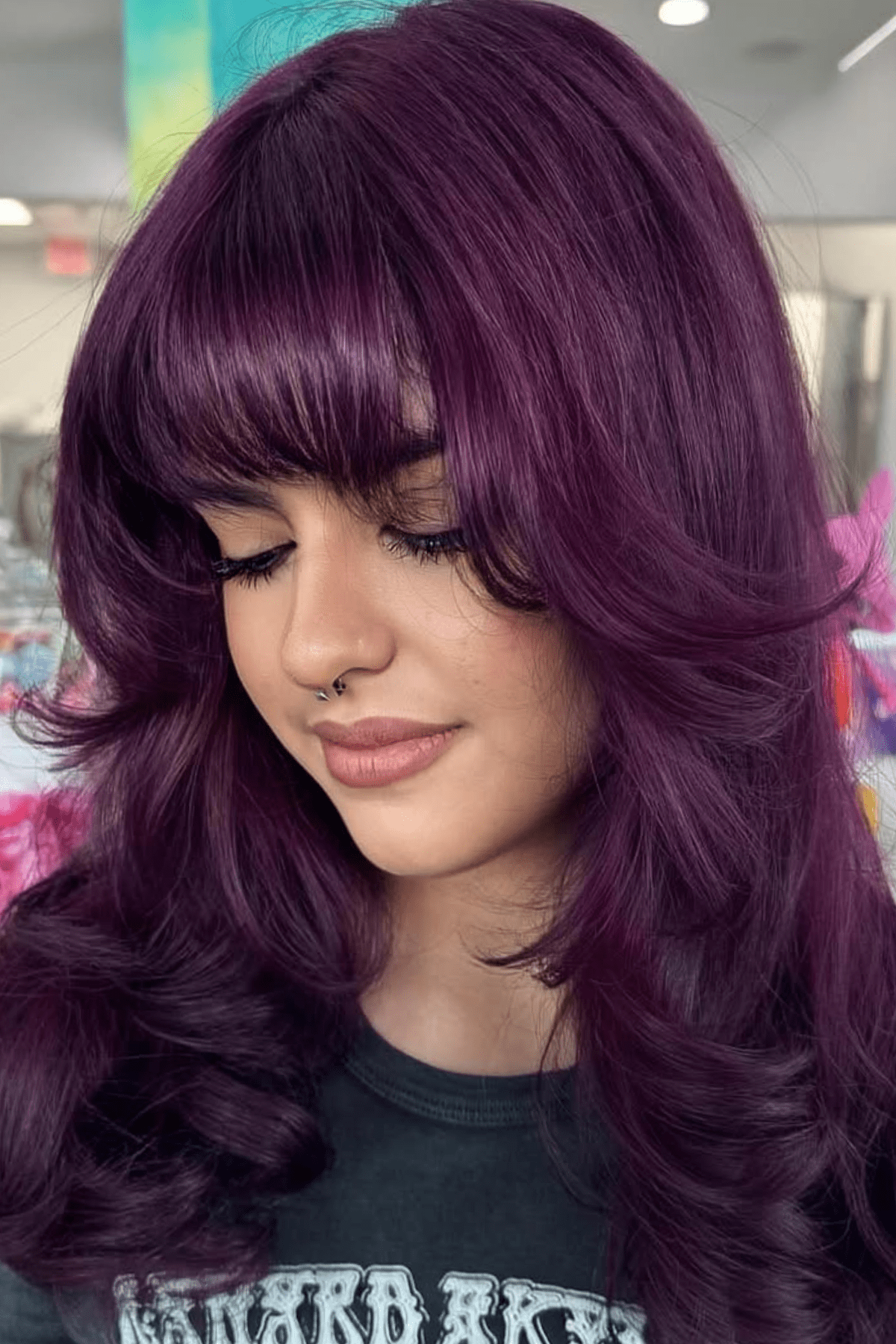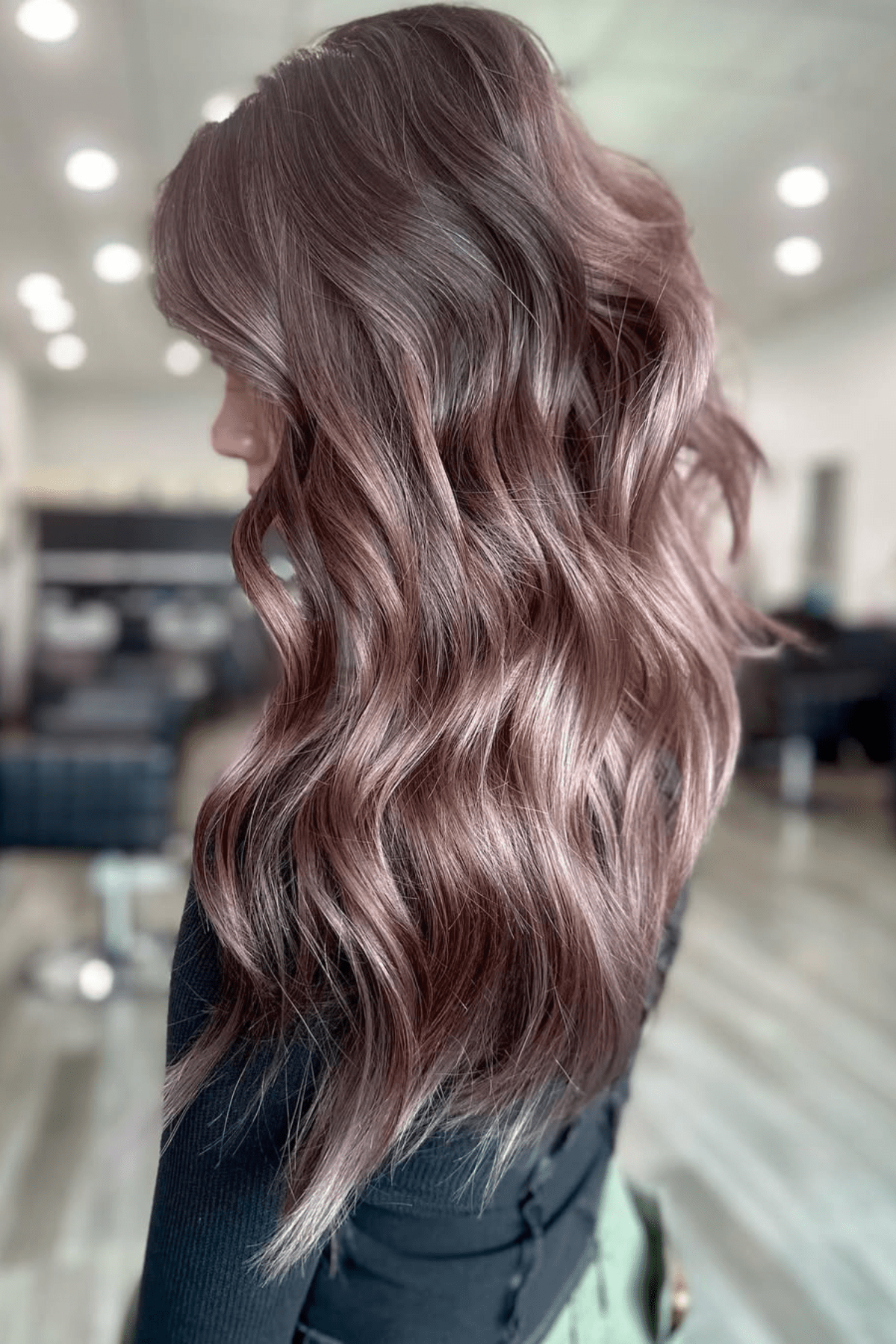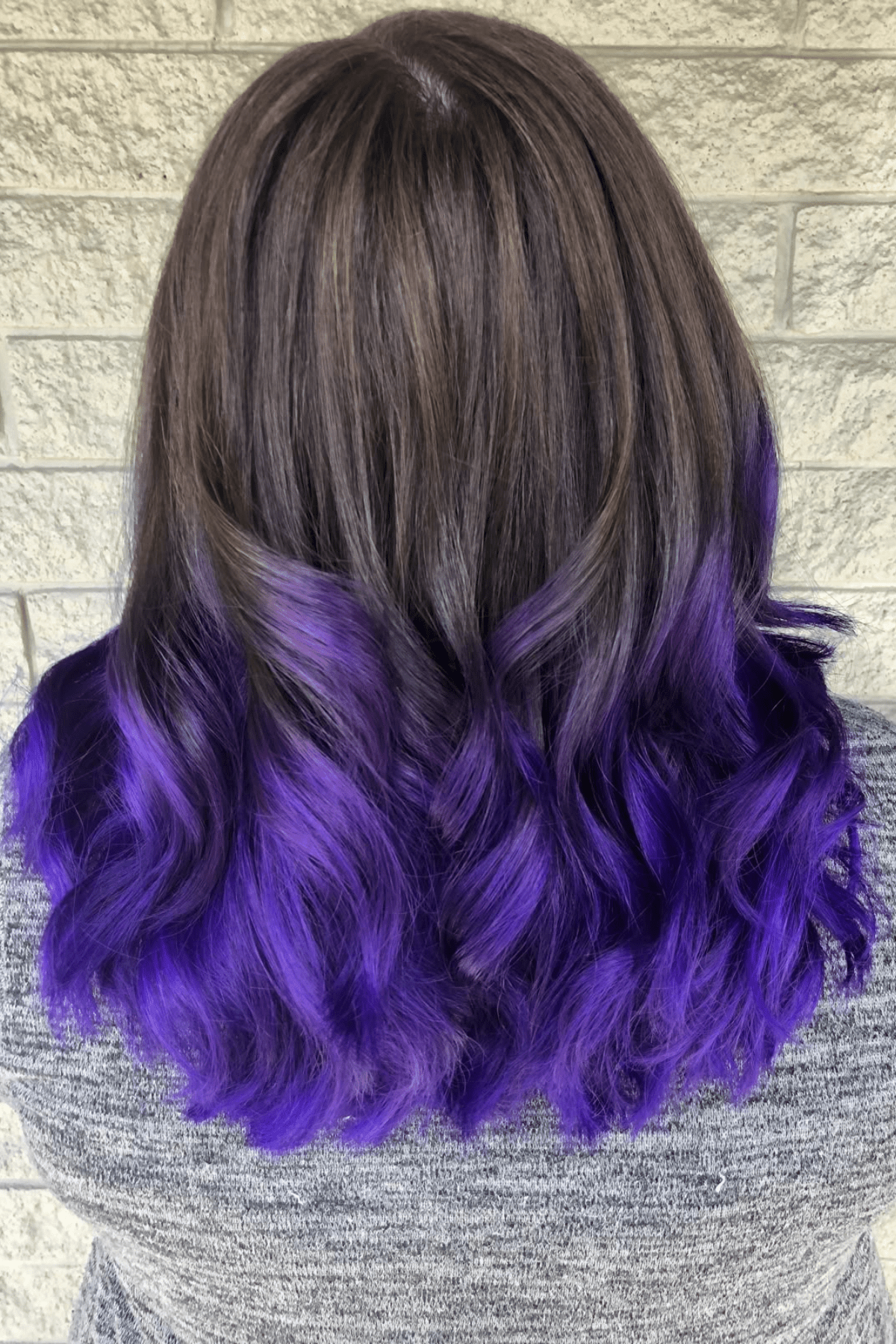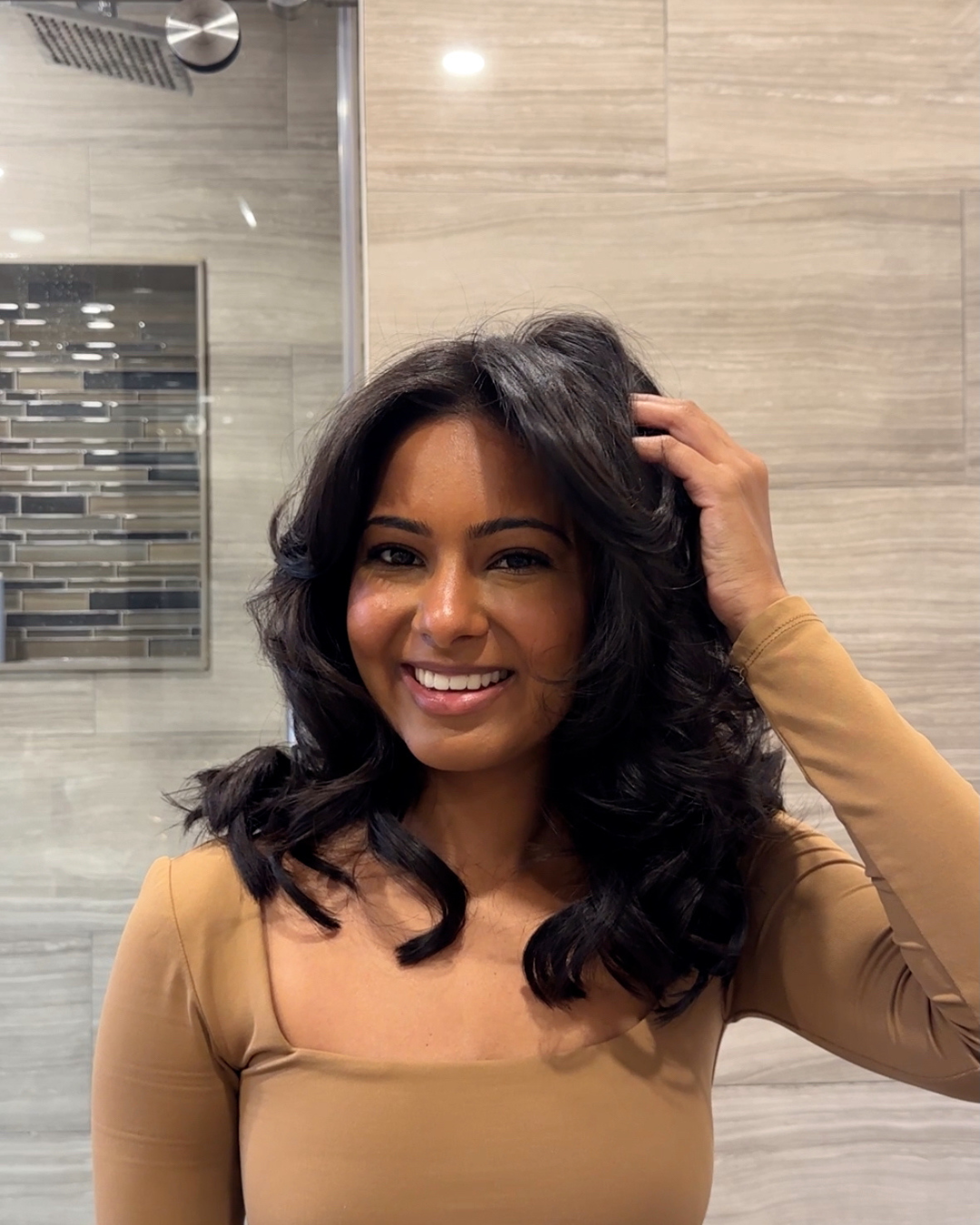11 Purple Hair Color Ideas That Won’t Fade Fast (And How to Maintain Them)
This post may contain affiliate links, which means I'll receive a commission if you purchase through the link at no extra cost to you. Please read the full disclosure here.
TL;DR
Purple hair color is not one size fits all. It comes in a full spectrum of shades, from soft lavender and periwinkle to bold plum and neon magenta. In this guide, you will learn how to choose the perfect purple for your skin tone and hair base, understand which tones fade faster, and explore 11 stylist approved ideas from hidden violet layers to dramatic split dyes. You will also get salon phrasing tips, at home care advice, and expert insights from behind the chair to help your color stay vibrant, not splotchy or short lived. Ready to find your perfect match? Grab my Free Hair Color Guide here and let’s make your purple pop.
You’re not alone if you’ve ever scrolled Pinterest or TikTok, paused at a stunning purple hair transformation, and thought, “Could I pull that off?”
As a stylist with over a decade behind the chair, I’ve colored every kind of purple you can imagine, from soft lilacs on blonde hair to hidden violet layers on natural brunettes. And here’s the truth most blogs skip: purple isn’t just one color. It’s a whole vibe spectrum.
The trick to making it work (and keeping it cute beyond the first week) is knowing which shade of purple matches your skin tone, base color, and maintenance mindset. That’s exactly what this post is here to help you do.
Whether you’re craving a full-on plum makeover or just want a peekaboo streak to test the waters, I’ve got you covered with real-life ideas, pro color tips, and my stylist-approved maintenance advice.
Let’s find your purple match and make it pop.
Find Your Perfect Purple Hair Color Personality (So You Don’t Regret It Later)
Before you commit to a shade, let’s decode what “purple hair color” actually means in the salon. Because not all purples are created equal, and trust me, you don’t want to walk out with a tone that doesn’t match your energy (or skin tone).
Cool vs. Warm Purples
Some purples lean icy, like silvery lilac or periwinkle, perfect if your skin has cool or neutral undertones. Others are warmer, like magenta and plum, which tend to pop beautifully against golden or olive skin.
Pastel vs. Saturated Purples
Pastel purples (like lavender) fade faster, but they’re soft and dreamy, making them ideal if you want something ethereal. On the flip side, saturated tones like eggplant or bright magenta demand attention and offer longer wear when layered over darker bases.
Underdye vs. All-Over Purples
If you’re not ready for full commitment, a hidden underlayer of violet peeking through curls or a topknot might be your entry point. But if you’re the “go big or go home” type, rich plum roots to ends will give you that bold, uniform color payoff.
Purple Personalities: Which One Feels Like You?
| Shade | Description |
|---|---|
| Lavender | Dreamy and soft, low contrast, high glow, perfect for blonde bases. |
| Deep Plum | Confident and bold, holds its tone longer and pairs well with medium to dark hair. |
| Hidden Violet | Playful and low-maintenance, great for those testing the purple waters. |
| Magenta | Spicy and edgy, vivid and expressive, best on pre-lightened strands. |
Match Your Purple Hair Color to Your Skin Tone, Hair Base & Vibe
Here’s where most people go wrong with purple hair color: they pick a shade they love, but not one that loves them back. The trick is to line up your skin tone, natural base, and real-life maintenance capacity before booking that color session.
Let’s break it down.
Choose Purple Color by Skin Tone
Fair skin with cool undertones: You’ll glow in silvery lilacs, lavender, and periwinkle. These icy tones complement your skin without overwhelming it.
Medium skin with olive undertones: This is where deep plum and magenta shine. Their richness picks up the warmth in your skin while still feeling modern and bold.
Deep skin tones: You can rock saturated purples like royal violet, deep eggplant, or jewel-toned aubergine with ease. These colors reflect beautifully in sunlight and don’t require the hair to be lifted as light, which keeps damage minimal.
Match Your Purple by Base Hair Color
The lighter your starting point, the more pastel and cool-toned purples you can try. The darker your base, the more you’ll want to lean into deeper shades unless you’re willing to bleach first.
Natural blondes: Almost any purple will work, especially soft lilac or periwinkle.
Medium brunettes: Try plum, magenta melts, or violet balayage; the lift is minimal.
Dark brunettes or black hair: Go for glossed eggplant or hidden violet layers for max impact with minimal damage.
Pre-lightened or bleached hair: The sky’s the limit, just prep for frequent toning.
Your Purple Hair Color by Lifestyle
Low-maintenance babes: Hidden layers, peekaboo streaks, or demi-permanent purple glosses that fade gracefully.
Color junkies & bold changers: High-contrast ombré, full-violet fades, or magenta-to-burgundy melts (these look stunning when styled but require upkeep).
Professionals in conservative settings: Try muted mauve or plum lowlights that blend easily with natural hair color.
11 Purple Hair Color Ideas That Slay in Real Life
From soft lilacs to moody plums, here are 11 stylist-approved purple hair color ideas that work in real life, not just in filtered selfies. For each, I’m sharing the tone, who it suits, how to ask for it in the salon, and a tip to keep it looking salon-fresh.
Hidden Violet Underlayers
Source: Instagram
Hidden violet is one of the most versatile ways to play with purple hair color without fully committing. This look tucks rich, cool-toned violet underneath your natural base, usually from the mid-lengths down, so the purple only peeks through when you move, curl, or flip your hair.
It works especially well on medium to dark brunettes who want something bold but still workplace-friendly. Because it doesn’t require full lighting, the integrity of your hair stays intact. I typically use a direct dye or semi-permanent gloss for a soft fade-out. It’s a fun, flirtatious intro to fashion color with virtually no regrowth maintenance. Bonus: curls and layered cuts help this pop even more.
Lavender Balayage Fade
Source: Instagram
Lavender balayage is the dreamiest take on purple; airy, pastel, and seamless. The color starts as a gentle lavender mid-shaft and melts into icy or platinum ends for a watercolor fade effect. This style flatters cooler skin tones and is ideal for those with pre-lightened or naturally light blonde hair.
In the salon, I lift the base to a level 9 or 10, then tone with lavender gloss for a sheer overlay. It’s stunning but high-maintenance: pastels like this fade fast, especially on porous hair. A once-weekly lavender color-depositing mask and colour-safe shampoo are non-negotiable if you want to keep the color dreamy, not dingy.
Rich Plum All-Over
Source: Instagram
Plum is the go-to shade for those craving richness without the drama of a neon hue. This color blends deep purple with red and wine undertones, making it one of the most flattering purples across olive and medium-to-deep complexions. The finish is dark, glossy, and moody, with depth that looks luxe in both sunlight and shadow.
I recommend this for brunettes because it layers beautifully over a level 5–6 base with minimal pre-lightening. In the salon, I apply a demi-permanent or permanent dye for longevity, with an acidic gloss to seal shine. It’s one of the longer-lasting purples, but still benefits from color-safe shampoo and periodic refreshes every 5-6 weeks.
Lilac Peekaboo Streaks
Source: Instagram
Lilac peekaboo streaks are playful, creative, and ideal for experimenting. These soft violet-toned highlights are placed under top layers or around the face to pop through when styled making them a favorite for clients who want impact without a full transformation. Because lilac sits on the pastel side of the spectrum, I lift the hair to a level 9–10 before toning with a semi-permanent dye.
This shade works beautifully on blondes or light brunettes and suits cooler skin tone best. It fades quicker than saturated purples, but that’s part of the charm. A quick re-gloss every few weeks brings it right back to life.
Eggplant Purple Gloss Over Brunette
Source: Instagram
Eggplant gloss is a subtle, sophisticated twist on purple, perfect for natural brunettes who want something dimensional without bleach. The tone sits deep in the violet-red family, almost black in shade, but it reveals rich purple shimmer under direct light. I use a demi-permanent gloss over levels 3–5 to enhance shine and tone without lifting.
This is one of my favorite choices for clients who want a seasonal shift without the commitment. It flatters warm and cool undertones equally and grows out softly, making it an ideal first step into vivid color. Plus, maintenance is a breeze: a color-safe shampoo and a violet conditioner every other week will keep the depth rich and reflective.
| Hair Color Inspiration for the Season |
|---|
| Browse these trending hair color ideas that suit a variety of looks, from warm tones to easy low-maintenance options: Explore these guides to find the shade that fits your style and the season. |
Periwinkle Highlights on Ash Blonde
Source: Instagram
Periwinkle is that perfect in-between of lavender and baby blue; a soft, dreamy, cool-toned purple that feels both ethereal and editorial. When painted as highlights on an ash blonde base, the result is fresh and icy with just enough personality. This shade works best on level 9–10 blondes with cool or neutral undertones in their skin.
I like to foil in soft periwinkle ribbons through the mid-lengths and ends, using a semi-permanent direct dye over-toned blonde for a clean, silvery finish. Because it sits between violet and blue, it can fade unpredictably without the right upkeep. Weekly toning masks and avoiding hard water are key to keeping the hue from shifting too blue or gray.
Bright Magenta Melt into Burgundy
Source: Instagram
This bold blend starts with vivid magenta at the crown and melts seamlessly into deep burgundy toward the ends; a high-contrast, high-impact color story that oozes confidence. It flatters medium to dark skin tones beautifully and suits those who don’t mind turning heads.
In the salon, I lift the roots slightly (if needed), then apply a magenta direct dye into a custom burgundy mix for the melt. The red-violet undertones make this pop even on darker bases. To maintain it, I always recommend alternating between a color-protect shampoo and a red-depositing conditioner. This one photographs so well, especially when styled with curls or waves to show off the gradient.
Silver-Violet for Gray Blending
Source: Instagram
This elegant shade blends cool silver and muted violet to softly enhance or blend naturally graying hair. It’s a brilliant choice for clients who don’t want to cover their grays but still want a purposeful, polished tone. On levels 8–10 (or naturally gray/silver hair), I tone with a custom mix of lilac and silver gloss to neutralize yellow and add a soft lavender hue.
The result is a luminous, pearly finish that flatters fair to medium skin tones. It’s especially great for low-maintenance color wearers, as it fades gracefully into the natural gray. To keep it cool-toned, I recommend a purple toning shampoo once or twice a week and minimal heat styling.
Muted Mauve for Professional Settings
Source: Instagram
Muted mauve is your “grown-up purple”; understated, wearable, and office-approved. This shade blends soft violet and rose-brown undertones for a subtle hint of purple that still reads natural from a distance. It’s perfect for brunettes who want something different without screaming “fantasy color.”
I typically apply this as a demi-permanent gloss over a level 6–7 base for soft, smoky results. It suits all skin tones thanks to its neutral undertones and is low on maintenance; fading softly into a taupe-rose hue over time. Use a gentle, sulfate-free shampoo and refresh every 6–8 weeks for a consistently polished finish.
Neon Purple Tips Only
Source: Pinterest
Looking to dip your toe into bold color without the full plunge? Neon purple tips are high drama in a low-commitment zone. This style places vibrant, electric purple only on the bottom two to three inches of hair, making it easy to grow out or trim off. Best suited for light brunettes or blondes, this color requires lifting to at least a level 8 before applying a neon violet direct dye.
It’s especially fun on layered or shaggy cuts where movement shows off the ends. Neon shades fade fast, so I always recommend a UV-protecting leave-in and weekly color refresh mask to maintain brightness.
Split-Dye Purple + Black Combo
Source: Pinterest
If you love contrast and want a statement look that never blends in, this one’s for you. The split-dye trend divides the hair cleanly down the middle; half intense violet, half jet black. It works best on straight, blunt cuts where the parting is strong, but you can absolutely wear it curly or wavy for a more whimsical effect.
I usually bleach one side to a level 8–9 for the purple and leave the other side natural or tone it deeper with black gloss. The duality is dramatic, editorial, and very TikTok-approved. Maintenance-wise, it’s two-toned care: use a purple shampoo on one side and a in shower gloss treatment on the other.
Use This Free Guide to Choose the Right Shade with Confidence
If you’re feeling inspired but still unsure which purple shade is your best match, I created something to help.
My Free Hair Color Guide walks you through tone, base, and lifestyle factors so you can move forward with clarity, not confusion. Its your stylist-in-a-PDF.
How To Keep Your Purple Hair Color Vibrant
Purple hair color fades fast if it’s pastel, semi-permanent, or sitting on pre-lightened hair. But with the right routine, you can keep that hue vibrant, dimensional, and photo-ready for weeks longer.
Here’s what I recommend to every purple client in my chair:
Use a Sulfate-Free, Color-Safe Shampoo
Sulfates strip pigment and moisture, which is the fastest way to watch your purple go dull or uneven. Look for gentle, pH-balanced shampoos made for colored hair.
Wash in cool water to minimize color lift. Only shampoo 2–3 times a week max, use dry shampoo between washes to stretch time.
Add a Purple Color-Depositing Mask Weekly
This is a must. Think of these like a color top-up at home. I suggest applying a lavender, violet, or magenta-depositing conditioner once a week, depending on your base tone. Let it sit for 5–10 minutes to refresh the hue and tone down brassiness or fade.
Protect from UV and Heat
Both sunlight and hot tools fade purple like crazy. If you’re not using a thermal protectant or UV barrier daily, you’re letting your color slide.
Use a UV-shielding leave-in spray (especially if you’re outdoors often).
Always use a heat protectant before blow-drying or flat ironing, no exceptions.
For pastel tones, I recommend air drying when possible to reduce heat stress.
Gloss and Tone Every 4–6 Weeks
Even if your purple hasn’t completely faded, it can go flat or uneven. That’s why I recommend coming in for a gloss or toner refresh around the 4-week mark. It helps seal in shine, revive tone, and rehydrate bleached strands.
If you’re DIY-ing, a semi-permanent gloss at home can work. Just be sure it matches your shade family (cool vs warm purple).
Pick the Haircut to Show Off Your Purple Hair Color
A bold purple shade deserves a cut that knows how to flaunt it. Whether you’re going soft lilac or deep plum, the right haircut adds movement, dimension, and visibility so your color doesn’t just sit flat. Here’s how to make your purple pop with shape.
Choose Layers to Show Off Color Placement
Layers are your best friend with multi-tonal purple shades like balayage, underlayers, or melts. They allow peekaboo colors to flash through curls, waves, or even a messy bun.
For hidden violets, go with mid-length shag layers or long curtain bangs.
For ombré fades, I love long, feathered layers to create softness and flow.
Add Face-Framing Pieces
If you’ve got a bold money piece or streaks of lilac at the front, a few well-placed face-framing layers can make the color feel intentional, not just trendy. It also draws attention to your eyes and cheekbones, which is so flattering with vivid tones like magenta or periwinkle.
Keep the Cut Low-Maintenance (If the Color Isn’t)
If your color needs frequent toning or re-glossing, choose a haircut that won’t need trims every 4 weeks, too.
Try a blunt lob with a subtle interior layer; easy to grow out, and it keeps ends looking full.
If you’re wearing short or shaggy cuts, just know they’ll need more frequent shaping to avoid awkward grow-out with bold hues.
FAQs About Purple Hair
What skin tone suits purple hair?
Almost every skin tone can wear purple. It comes down to choosing the right undertone.
Cool skin tones: silvery violet, lilac, periwinkle.
Warm or olive tones: magenta, plum, burgundy based purples.
Deep skin tones: eggplant, royal violet, and other jewel tones.
What are the 7 shades of purple?
Here are seven salon favorite purple shades:
- Lavender
- Lilac
- Plum
- Violet
- Magenta
- Eggplant
- Periwinkle
Each shade has its own vibe, tone, and level of boldness.
Does purple hair dye fade easily?
Yes, especially pastels. Lighter purples like lavender and lilac fade faster because they sit on a more porous pre lightened base. Deeper purples such as plum or eggplant last longer but still need sulfate free care and refreshers to stay vibrant.
Is purple or blue hair better?
It depends on your skin tone and how much upkeep you want.
- Purple tends to be more forgiving as it fades, often shifting into pink or mauve tones.
- Blue can fade greenish, especially on warm or yellow based blondes.
If you are new to vivid colors, purple is usually the easier and more flattering option.
Does purple look good on dark skin?
Absolutely. Deep skin tones look stunning in saturated shades like violet, plum, magenta, and eggplant. The contrast creates a beautiful, vibrant result.
Who can pull off purple hair?
Anyone can, with the right tone and placement. If you are unsure, start with a peekaboo layer or a soft purple gloss. Maintenance and confidence make all the difference.
What is the prettiest color of purple?
It depends on your style. Lavender is soft and dreamy, plum is classic, and magenta is bold. The prettiest shade is the one that fits your vibe and flatters your undertone.
Final Word from Haiirology
Purple hair color is more than a trend, it’s a statement. Whether you lean toward soft lilacs or bold plums, the key to pulling it off is picking a shade that complements your skin tone, works with your base color, and fits your lifestyle. There’s a version of purple for everyone, yes, even you, and with the right care, it can be one of the most fun, flattering colors you’ve ever worn.
As a stylist, I’ve helped so many clients fall in love with purple in a way that feels authentic, low-stress, and seriously eye-catching. So if you're ready to experiment, trust yourself. Start subtle or go all in. Just promise me you’ll treat your color with care because vibrant hair deserves vibrant energy to match.
Tag me @HaiirologyByJen on Instagram if you try any of these shades, I'd love to see your look!
And if you're still unsure which shade is your perfect match, grab my Free Hair Color Guide to take out all the guesswork.


























Not sure which cherry red hair color suits you? This guide breaks down the best shades by skin tone, maintenance level, and hair type.